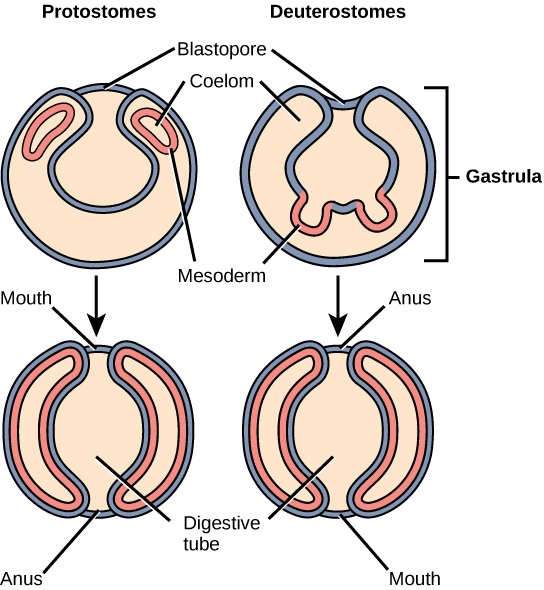| << Chapter < Page | Chapter >> Page > |
The earliest distinction between protostomes and deuterostomes is the type of cleavage undergone by the zygote. Protostomes undergo spiral cleavage , meaning that the cells of one pole of the embryo are rotated, and thus misaligned, with respect to the cells of the opposite pole. This is due to the oblique angle of the cleavage. Deuterostomes undergo radial cleavage , where the cleavage axes are either parallel or perpendicular to the polar axis, resulting in the alignment of the cells between the two poles.

There is a second distinction between the types of cleavage in protostomes and deuterostomes. In addition to spiral cleavage, protostomes also undergo determinate cleavage . This means that even at this early stage, the developmental fate of each embryonic cell is already determined. A cell does not have the ability to develop into any cell type. In contrast, deuterostomes undergo indeterminate cleavage , in which cells are not yet pre-determined at this early stage to develop into specific cell types. These cells are referred to as undifferentiated cells. This characteristic of deuterostomes is reflected in the existence of familiar embryonic stem cells, which have the ability to develop into any cell type until their fate is programmed at a later developmental stage.
Animals that do not have a coelom are called acoelomates. Flatworms and tapeworms are examples of acoelomates. They rely on passive diffusion for nutrient transport across their body. Additionally, the internal organs of acoelomates are not protected from crushing.
Animals that have a true coelom are called eucoelomates; all vertebrates are eucoelomates. The coelom evolves from the mesoderm during embryogenesis. The abdominal cavity contains the stomach, liver, gall bladder, and other digestive organs. Another category of invertebrates animals based on body cavity is pseudocoelomates. These animals have a pseudo-cavity that is not completely lined by mesoderm. Examples include nematode parasites and small worms. These animals are thought to have evolved from coelomates and may have lost their ability to form a coelom through genetic mutations. Thus, this step in early embryogenesis—the formation of the coelom—has had a large evolutionary impact on the various species of the animal kingdom.
Organisms in the animal kingdom are classified based on their body morphology and development. True animals are divided into those with radial versus bilateral symmetry. Generally, the simpler and often non-motile animals display radial symmetry. Animals with radial symmetry are also generally characterized by the development of two embryological germ layers, the endoderm and ectoderm, whereas animals with bilateral symmetry are generally characterized by the development of a third embryological germ layer, the mesoderm. Animals with three germ layers, called triploblasts, are further characterized by the presence or absence of an internal body cavity called a coelom. The presence of a coelom affords many advantages, and animals with a coelom may be termed true coelomates or pseudocoelomates, depending on which tissue gives rise to the coelom. Coelomates are further divided into one of two groups called protostomes and deuterostomes, based on a number of developmental characteristics, including differences in zygote cleavage and method of coelom formation.
[link] Which of the following statements is false?
[link] C
[link] Which of the following statements about diploblasts and triploblasts is false?
[link] D

Notification Switch
Would you like to follow the 'Biology' conversation and receive update notifications?